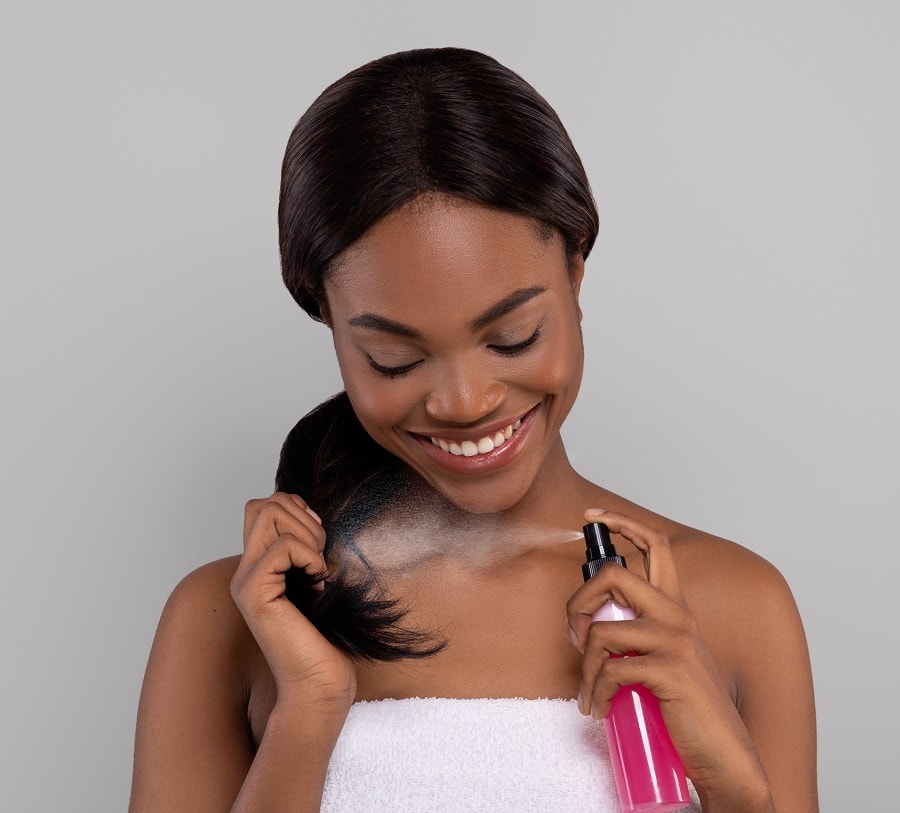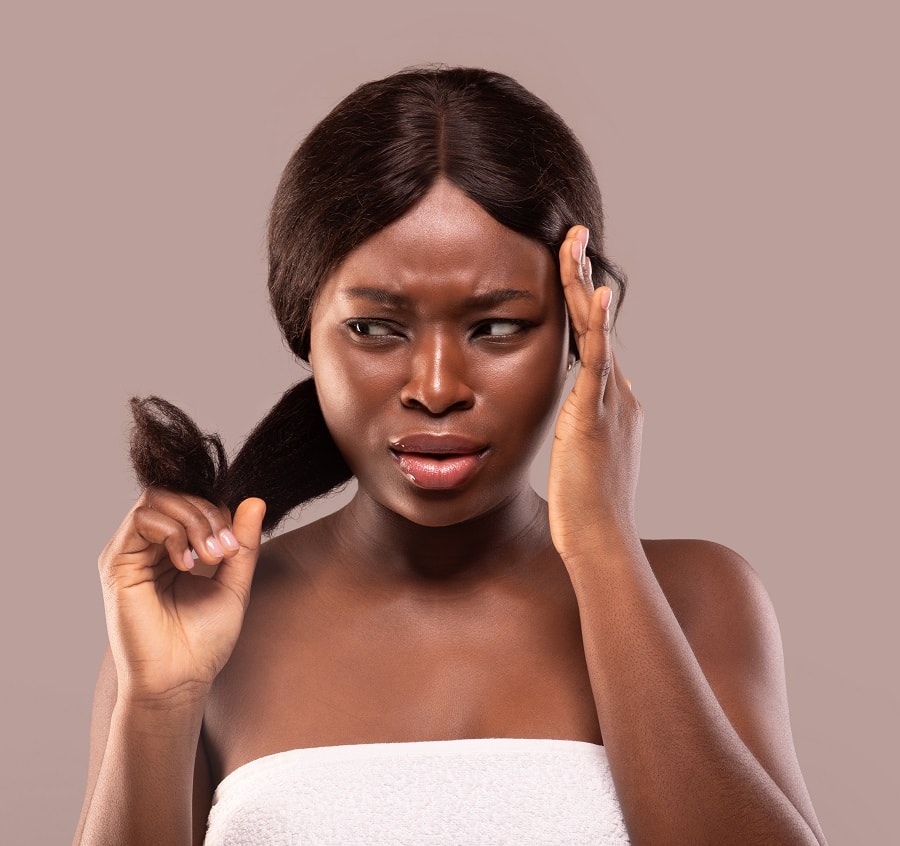
How to take care of relaxed hair and extend it – HairstyleCamp
If you’ve decided to grow out your relaxed hair but are still struggling, don’t let that frustration stop you from reaching your hair goals. Keep your relaxed hair the right way and watch it grow and be healthier.
Relaxed hair is no easier or harder to care for than natural hair. You can learn how to care for relaxed hair and lengthen it in a few minutes. We’ve researched, listened to some relaxed hair care experts, and compiled a list of dos and don’ts to help you take care of your relaxed hair.
Does relaxed hair grow?

Relaxed hair grows unless someone has an underlying health problem or condition that prevents hair growth, such as baldness or mineral deficiency. Hair grows from the scalp, whether it is natural, dyed, relaxed or has undergone any other chemical and natural treatment.
As long as there are no internal body problems or scalp problems, your hair will grow regardless of the processes you used on the strands.
How to take care of your relaxed hair
It is important to keep your hair relaxed. Here are our top nine tips for taking care of relaxed hair:
#1. Keep your scalp and hair clean
Hair care always starts with scalp care. It is essential to keep your scalp clean to provide the right environment for hair growth. If your pores are blocked with oil and dirt, you will experience less hair growth and hair loss. A dirty scalp also invites dandruff, itching and inflammation.
Do not wash your hair too much as this will lead to a dry and inflamed scalp and dry hair. For the most part, washing the scalp weekly with a moisturizing shampoo and once a month with a clarifying shampoo works.
This schedule can vary depending on how much you exercise, the climate where you live and the seasons. You can also try co-washing in the middle of the week.
#2. Keep your hair and scalp moisturized

Keeping hair moisturized can help stop breakage, which leads to better length retention. A moist scalp is less likely to be inflamed, oily or dry.
Some people do a moisturizing and sealing routine every other day. Others do it only on laundry day or twice a week. Try different methods and find what works for your hair. Do not saturate your hair with the product when moisturizing.
It is impossible to moisten with oils and butter. Use moisturizers like water-based mists, serums, and leave-ins. Make sure the first ingredient is water and most of the ingredients are humectants like aloe vera, honey, butylene glycol and glycerin. Seal with a light oil like grape seed or sesame oil to avoid weighing down the hair and causing breakage.
#3. Eat well and stay hydrated
It is essential to nourish and hydrate our body for hair health. Include more fruits and vegetables in your diet to get micronutrients and vitamins. Drink at least two liters of water daily, adjusting to the seasons and movement.
Make sure you eat plenty of protein to help grow your hair and keep it strong. Most protein sources are also rich in vitamin B, calcium and iron, which are necessary for hair growth. Get outside and get some vitamin D as often as you can.
Consult a doctor to find out if you are deficient in minerals such as iron and omega-3 and vitamins such as B, D, C, K and A. Complete what you lack.
#4. Have a consistent relaxing schedule but avoid over-processing
You must stick to a regular relaxed schedule. Many people experience breakage because they don’t relax their hair on a regular schedule. Unless you’re going wild, find a timeline that works for you and stick to it.
You can stretch your relaxer as long as you want. However, the more natural hair you have, the higher the chance of breakage due to the difference in texture.
When stretching your relaxer, be extra careful and gentle. If you can’t stretch the relaxer without damaging your hair, relax your hair after eight weeks to ensure length retention.
#5. Deep condition and use protein treatments

Deep conditioning is a great way to provide relaxed hair with the nutrients and moisture it needs to maintain length. Look for deep conditioners that are full of moisturizers.
You can add light oils to help nourish your hair if the deep conditioner doesn’t already contain them. Most people use deep conditioners once a week, so try this schedule and adjust as your hair needs.
Protein treatments can be used bi-weekly, monthly, every six weeks or every two months. Your schedule will depend on your hair porosity and how your hair reacts to the protein. You can also choose to use a protein moisture balanced treatment instead of a pure protein treatment.
#6. Be smart with color
If you want to dye your relaxed hair, be very careful. Get a professional to examine your hair and determine its health and condition.
Avoid bleaching or coloring your hair for at least two weeks before and after receiving a fresh relaxer. This ensures that you don’t overwork the hair and cause breakage. Use only professional paint and do not overdo it.
For those who are trying to dye their hair darker, make sure you get a professional color and have a certified hairstylist do it. Also, it is advisable to wait two weeks after relaxing to dye it darker. You will be able to maintain more hair length by avoiding back-to-back processing.
#7. Avoid direct heat and excessive manipulation of your hair
Relaxed hair is more prone to breakage than natural hair. Your hair has already gone through an intense chemical process to rebuild the bonds. Limit your use of direct heat such as a flat iron or curling iron.
Avoid daily styling, coarse combing and high tension hairstyles. When using protective hairstyles, stick to low manipulation and low tension styles.
#8. Cut a dead end

Holding on to dead, split ends only causes more damage. To avoid long but damaged hair, trim your hair. Have a professional you trust check for split or dead ends and trim them.
To avoid stunting, keep scissors at home. Check for split ends yourself and trim immediately. Split ends move up the hair strand, causing even more breakage. Over time, you’ll find that you hold onto longer hair because your hair doesn’t break as often.
#9. Protect your hair when you sleep
When you go to bed, keep your hair protected with a stocking, bonnet, hat, scarf or socks. Ideally, use items made of silk or satin as these materials prevent your hair from frizzing and reduce friction.
Protecting your hair at night will ensure no tension or friction on the strands while you sleep. For long, relaxed hair, braid it in sections before wearing the bonnet or scarf.
Why is my relaxed hair not growing?
Here are the reasons why your relaxed hair is not growing:
- You don’t treat or treat your hair, depriving it of nutrients and moisture to maintain length
- You are over-manipulating your hair by heat styling, over styling or using high tension hairstyles
- You relax too soon without enough new growth and thus overprocess your hair
- You stretch your relaxer too much and thus experience more breakage due to too many hair textures on your head
- Your scalp is dirty or inflamed, causing clogged pores
- You suffer from a hormonal imbalance or baldness, which causes hair loss and lack of hair growth
- You do too many chemical processes on your hair, like coloring or bleaching.
How long should I wait to reapply relaxer when growing hair?
You should wait at least eight weeks before relaxing your hair again. You need enough new growth to relax to avoid over-processing already relaxed hair. On average, hair grows half an inch every four weeks. For those whose hair grows fast, you may have up to 4 inches of growth in eight weeks.
You can choose to wait just the eight weeks or stretch your relaxer. Some people stretch out their relaxers for up to six months. However, your hair is more likely to break and look dull when you wait too long between relaxers. Find what timeline works best for your hair to ensure you maintain length and avoid over-processing or breakage.
So how to grow long and healthy relaxed hair?
The key to growing long and healthy hair is maintaining good overall health, scalp care and preventing breakage. You want to focus on:
- Eating protein-rich foods to nourish your hair from the inside out
- Protecting your hair and avoiding too many manipulations
- Deep condition your hair often
- Maintaining protein moisture balance to prevent breakage
- Keeping your scalp clean and moisturized
- Avoiding relaxer overlap by waiting for sufficient growth before retouching and protecting previously relaxed hair with conditioner, grease or balm.
If you consistently follow these steps, you will notice much less breakage in your hair. You can supplement these with hair supplements, scalp massages and rosemary oil if you need help regrowing lost hair. Trial and error will help you find which balance of the above steps works best for your hair.
Common questions
If you’re looking to grow out your relaxed hair, it’s important to know what works and what doesn’t.
Rice water cannot help hair grow but can help relaxed hair maintain length. It should be well prepared and you should monitor how your hair reacts to it closely.
Some people’s hair doesn’t like rice water for various reasons, including too much protein. As with all other hair treatments, if your hair is fine, don’t try it.
Yes, many oils have been shown to help with hair growth. You can use oils like rosemary, pumpkin seed oil and peppermint oil diluted with a carrier oil like jojoba or grape seed to help your hair grow.
These oils can lower a hormone known as DHT, which causes hair loss. They also stimulate hair growth by extending the telogen phase.
Hair also doesn’t grow as fast as your genetics allow. Whether your hair is relaxed or natural, it will grow at the same rate.
Some people notice more growth in relaxed hair due to the clear demarcation between natural and relaxed hair. Others will say that their natural hair grows faster, but this is usually because they take better care of it than their relaxed hair and thus retain more length.
Yes, if you don’t relax your new growth, you can transition to natural hair over time. After six months to a year of relaxed hair growth, you may lose your previously relaxed hair as it breaks due to the different textures. At this point, you will switch to natural hair.